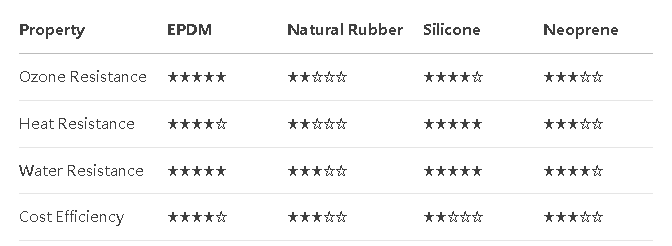Introduction:
Have you ever wondered what keeps your car interior perfectly dry while rain drums on the roof? The answer lies in a material called Ethylene Propylene Diene Monomer (EPDM) rubber. As an invisible guardian of modern industry, EPDM seamlessly integrates into our lives through its exceptional weather resistance and sealing capabilities. This article decodes the technology behind this “long-life rubber.”
1. What is EPDM Rubber?
Chemical Identity:
EPDM is a polymer synthesized by copolymerizing ethylene (E), propylene (P), and a small amount of diene monomer (D). Its unique “ternary” structure delivers dual advantages:
-
Ethylene + Propylene: Forms a backbone resistant to aging and chemical corrosion
-
Diene Monomer: Introduces crosslinking sites for vulcanization and elasticity
Core Performance Highlights:
Weather Resistance King: Withstands UV rays, ozone, and extreme temperatures (-50°C to 150°C)
Anti-Aging Expert: Service life of 20-30 years
Sealing Guardian: Low gas permeability, high resilience
Eco Champion: Non-toxic, odorless, and recyclable
2. Where You Encounter EPDM Daily
Scenario 1: Automotive Industry’s “Sealing Specialist”
-
Window Seals: Core barrier against water, noise, and dust
-
Engine Systems: Coolant hoses and turbocharger pipes (high-temp resistance)
-
EV Battery Packs: Waterproof seals for high-voltage safety
-
Sunroof Tracks: UV resistance for decade-long performance
Data: Average car uses 12kg of EPDM, accounting for >40% of all rubber components
Scenario 2: Construction Sector’s “Climate Shield”
-
Roofing Membranes: Core material for single-ply roofing systems (30-year lifespan)
-
Curtain Wall Gaskets: Resists wind pressure and thermal expansion
-
Underground Seals: Ultimate defense against groundwater infiltration
Scenario 3: Household’s “Silent Partner”
-
Appliance Seals: Washing machine doors, refrigerator gaskets
-
Sports Surfaces: Eco-friendly track granules
-
Children’s Toys: Safe elastic components
3. EPDM Evolution: From Basics to Smart Formulations
1. Nanotechnology Enhancement
Nanoclay/silica additives increase strength by 50% and double abrasion resistance (used in Tesla Model Y battery seals).
2. Green Revolution
-
Bio-based EPDM: DuPont’s 30% plant-derived monomers
-
Halogen-Free Flame Retardants: Meets EU RoHS 2.0 standards
-
Closed-Loop Recycling: Michelin achieves 100% recycled seals
3. Smart-Response EPDM
Lab-developed “self-healing EPDM”: Microcapsules release repair agents when damaged (future potential for spacecraft seals).
4. EPDM vs. Other Rubbers: Performance Showdown
Note: EPDM wins overall for weather resistance and value, making it the top choice for outdoor seals
5. Industry Trends: EVs Fueling EPDM Innovation
Electric vehicle growth drives EPDM advancements:
-
High-Voltage Sealing: Battery packs require 1000V+ resistant seals
-
Lightweighting: Foamed EPDM density reduced to 0.6g/cm³ (vs. 1.2g/cm³ standard)
-
Coolant Corrosion Resistance: New glycol coolants accelerate rubber aging
Market Forecast: Global automotive EPDM market to exceed $8 billion by 2025 (Grand View Research)
6. Cool Facts: EPDM’s “Impossible Missions”
-
Spacecraft Seals: ISS window seals maintain integrity for 20+ years
-
Undersea Tunnels: Hong Kong-Zhuhai-Macao Bridge joints designed for 120-year service
-
Polar Exploration: Core material for -60°C Antarctic station seals
Conclusion: The Sustainable Future of an Understated Champion
Over half a century, EPDM has proven true technology lies not in visibility but in reliably solving real-world problems. As global manufacturing turns green, EPDM’s recyclability and longevity make it vital for the circular economy. Next-gen functional EPDM will push performance boundaries, continuing to guard everything from daily life to outer space.
Post time: Jul-09-2025

